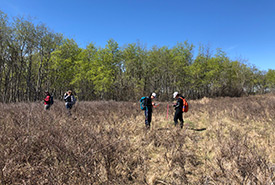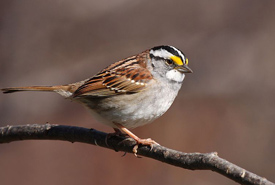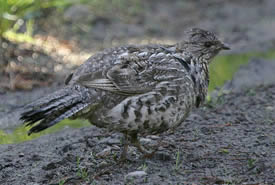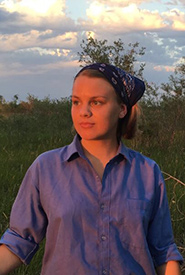Connecting to the land through conservation

We spent the morning walking NCC’s Ursulan property. (Photo by NCC)
On my first field day with the Nature Conservancy of Canada (NCC), I was expecting a rigorous day of mapping, tracking and other GPS functions I don’t understand. Instead, I found myself birdwatching my way around a beautiful piece of NCC land with a group of people who have a well-developed connection to Saskatchewan’s natural areas and native species.
We spent the morning walking NCC’s Ursulan property, with the primary objective of monitoring the conservation of this land, and the secondary goal of just getting out and experiencing the meaningful beauty of preserved grassland. Despite following the sight of a long-eared owl through a forest, we still ended up at the fence that we were there to check up on.
Related blog posts
My NCC colleagues know how to put down the clipboard and pick up their binoculars. Fostering a connection to this land and the species that inhabit it is a vital part of the work that NCC does. As Jennifer McKillop, regional vice-president for Saskatchewan Region, said in her welcome presentation to the interns, “If you don’t connect people to nature, how can you expect them to care?”

White-throated sparrow (Photo by Wikimedia Commons)
Her statement was in reference to the 17 NCC properties in Saskatchewan that are open to the public, as well as the Conservation Volunteers events that we hold on those and other properties.
When NCC invites you to go out and walk preserved native grassland on your own or come help us collect native grass seeds as part of a property’s restoration plan, the main motivator, beyond exercise and native grass restoration, is giving you an opportunity to create a deeper connection to Saskatchewan’s remaining natural areas. The results of donating to NCC or volunteering with our conservation team are tangible; you can walk the hills, see the wheatgrass, hear the white-throated sparrow.
NCC knows that all it takes to make a connection to the preservation of native prairies is getting out and walking on these beautiful landscapes, because that is what NCC’s conservation employees take the time to do themselves.

Ruffed grouse (Photo by Bill Hubick)
What stood out to me the most in my first week here was that these seasoned conservation workers and scientists still let the sound of a ruffed grouse in the bushes stop them in their tracks. They don’t forget why they are out in a field taking reference photos of fences on a point-and-shoot camera or writing “dilapidated corral” in a notebook.
NCC’s mission is to work to “protect ecologically significant lands and the species they sustain.” What you and I do or don’t do to protect this land is ecologically significant; we have a vital and powerful role in the relationships among living organisms. In addition, humans are one of the species that these natural lands sustain. NCC works with an awareness of the connectivity of all things — from little bluestem to big business — as well as the pressing need to make others just as aware.
You have a place in the conservation of the plains. Find your connection.


